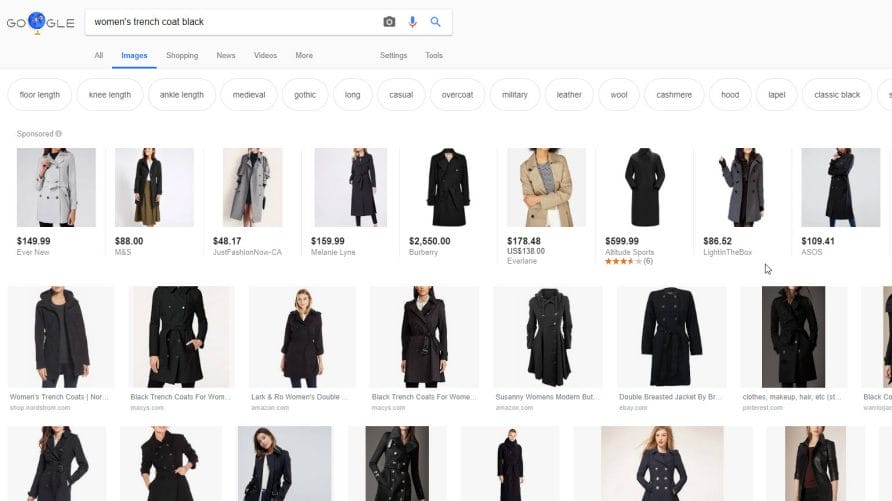I am walking into work on a misty fall day, wishing I was wearing a warmer coat. It gives me an idea, I should order a new coat, so that tomorrow, I don’t have to drink three cups of coffee when I arrive to work to warm up. To start the process, I say, show me a trench coat that fits me, that I can get delivered by 9am tomorrow. My sunglasses bring up three styles for my review superimposed on an image of me, so I can see what I would look like. I say, “order the grey one with polka dots and deliver it to my home”. I walk more briskly to warm up, with the knowledge that I’ll be wearing my new polka dot coat tomorrow to battle the London dampness.
While this reality does not exist today, elements of it do, and evidence to how the “futuristic” parts are really more reality than fiction.
I never went to a site to shop, I merely asked for the information I needed to make a decision, reviewed the styles based on my personal taste and look and then proceeded to make the transaction all while never landing on a retailer’s website, or browsing their catalog.
This change requires companies to start managing their brands for machines. Machines like Google, Bing, Alexa, Siri, and extending as far as a Tesla car or your connected fridge. It means that marketers have a new role, they need to not only think about their brand in the context of how humans understand your content, but also machines.
This was the specific topic of a panel I chaired at Retail Week’s Tech conference in London, UK where Wendy Stonefield of Deloitte Digital, Nick Wilsdon of Vodafone, and Dawn Anderson of Move-it-Marketing shared how we saw the world changing.
“Brands are still spending large sums to build, promote and portray their brands as they wish them to be perceived across various channels. Proctor and Gamble is at the number 1 slot of the spenders with an impressive $7.12 billion in 2017, a collection of 17 auto brands spent $51 billion, and internet companies are rising through the ranks of spenders – such as Alibaba, Tencent, Rakuten and Amazon who is number 11 with a budget of $5 Billion ahead of Ford Motors, Coca-Cola and McDonald’s.” says Wendy Stonefield of Deloitte Digital London.
Building, managing and sustaining brand image is more important than ever, but more and more challenging in the world where the customer experience is becoming fractured and owned by Google, Amazon, Apple, and not the brand itself.
Loss of the Customer Experience
There is plenty of evidence that supports that brands are losing control of the customer experience. Here are a few that illustrate the change and I believe are support for where things will be going.
Job Search
If you do a job search in Google, you see a list of jobs for your area or discipline, can filter based on needs (full time vs part-time), and also keywords. But here’s the kicker, if you choose a filter, Google takes you directly to the job post to read the details!
We see the same behaviour for Events, and answers to common questions.
Health Information
Over the years we have seen the knowledge panels and answers in search evolve. Today, if you do a search for a specific medical condition, for example, Hashimoto’s disorder, details, and common questions are listed directly in search.
Product Research and Purchase
When searching for products, if you are a visual buyer, you can find out information about the product, the price, reviews directly in the image search results. The impact is that the research is being done off your website, so there is no evidence of interest until they purchase or don’t.
It makes sense that Google wants to keep you in the search results as long as possible, since the longer you are there, the more ads they can display, and the more money they make.
Voice Search
Don’t believe me that the customer experience is moving away from your website? OK, let’s talk about Alexa. Amazon has done a great job getting us excited about asking Alexa questions, having her build our shopping list, or playing “We will Rock You” for dance parties in the kitchen. What we haven’t all realized is that Alexa’s presence means that we are informing Amazon of our preferences, family habits, and are being provided with very easy access to a single ordering channel. As a working parent, I can’t help but revel at the experience of creating my personalized shopping list and having it ordered, never having to get out pen or paper, or leave my home.
I believe that Google and Amazon are only at the tip of the iceberg with this trend. We know that Apple is playing already in the voice assistant world with Siri, Google too with Google Home, and that Facebook are working on their voice strategy. Microsoft recently announced how they are using Bing across their customer experience to bring data from search, email and the desktop into results.
Challenges for Retailers and Large Organizations
Retailers are already struggling with the changes of the current internet with online brochures/flyers, ecommerce, and social. The largest retailers not only have to keep up with the pace of change across channels, but they also have the challenge of being large, slow and complicated. Their size alone makes it difficult to keep up.
And now they have to figure out how to manage their brand for the machine channel?
Wendy adds, “The introduction of voice search, the Internet of Things (IoT), Chatbots, are all there for the taking or breaking of brands.”
The challenges are real. How do you get a large organization to be nimble enough to change, and move quickly to take advantage of these changes, while bringing value to the organization in the process?
Nick Wilsdon from Vodafone, shared his biggest challenge in trying to be agile in this very fast, evolving “machine channel” In his role as the Head of Search, he is challenged with finding ways for Vodafone to show up in search in Google, but also in voice, on Alexa. Simply put, his challenge is Data.
“Data is spread out and siloed. For example, the team built a well-received Vodafone Alexa Skill to let pay monthly customers to retrieve their bill amount, question bill differences over the month and find information on new services. However, this application currently only works for accounts paid monthly and not pay as you go (PAYG) or B2B customers.”
“In addition, driving change is slow. To overcome this, we come up with small tasks that move things forward and celebrate their achievements. For example, organise a hackathon with your developers over pizza. Create an agile environment, where teams can try new things and use the outputs to show executives the business value in managing the brand for these new channels.”
One of the key challenges is ownership. Is this new world of brand marketing a Marketing Initiative or IT. Dawn Anderson of Move-it-Marketing explains that “there are so many technological choices and options afforded to organizations, and at various stages of maturity, often knowing which is the optimal path to take is overwhelming.” So where should you start and who should lead it?
How to Start Building a Foundation for the Machine Channel
In my 15+ years working with Enterprise customers at Cisco and now at Schema App, I am a big believer that wherever you start, you need to be able to show value quickly, to support ongoing investment, and also to keep the teams engaged, and motivated.
Start with Structured Data
Marketing teams have an easy, high-value opportunity to help Google, Alexa, and other machine consumers understand their content using the advanced SEO strategy called Structured Data (aka Schema Markup).
What is Structured Data? In 2011, Google, Yahoo and Bing created a vocabulary called schema.org (a machine language), to help them understand content on web pages. This vocabulary enables companies to translate their content into machine language, aka code, and as a result of doing this translation, Google rewards the website with features in search and better-matched traffic because the content is fully understood.
We experience these enriched search results through review rich snippets, images in search, prices in rich results and more.
In November 2017, Gary Illyse from Google stood up and said, “[Add] structure data to your pages because, during indexing, we will be able to better understand what your site is about.” SEMpost
Today, Google, Bing, Alexa and others identify features as a result of embracing structured data, and we only see these accelerating. In the recent months, we’ve seen Google release new features, such Media, Speakable, Podcasts, and Fact Check. With Speakable being a specific feature to enable control on what is an answer is Voice Search.
Brands can leverage tools like Schema App Highlighter, or built in Apps in their Ecommerce Platform to add schema markup to content on your site you want customers to find, and therefore want the search engines and voice to understand. Many of these solutions require little to no IT involvement, empowering marketing to start managing the brand for machines, and speed to value.
As a result of taking this first step into managing your brand for machines, there will be tangible benefits such as increased organic search traffic, increase clicks, higher customer engagement and perhaps the opportunity to reduce paid Ad investments all while starting to future-proof the brand.
Voice Search Alexa Skill Pilot
Nick Wilsdon of Vodafone said it best, buy a couple of pizza’s and a couple of developers and build something simple. What should you build? We recommend looking at the top questions customer service teams get and turn them into a skill. Often companies are already answering these questions on their phone system (IVR). One digital marketing company, decided to create an Alexa Skill to answer the top questions in their area of search expertise, so that they could showcase the value of owning that answer. Retailers might start with answering questions about their locations opening hours. Something I can imagine asking Alexa as I sit on the couch browsing clothing in search results.
Take Control of How your Brand is Understood by Machines
We have lost control of the customer experience, and it is only just starting. Retailers and Brands can start taking control of this new sales and marketing channel with some advanced SEO tactics, and through experiments to show value, and the experience of the future.
Marketers have a new role, they need to not only think about their brand in the context of how humans understand your content, but also machines.
If you need a hand getting started with your structured data strategy, we’ve helped customers such as SAP and Keen Footwear drive more quality search traffic to their websites.
Start reaching your online business goals with structured data.




